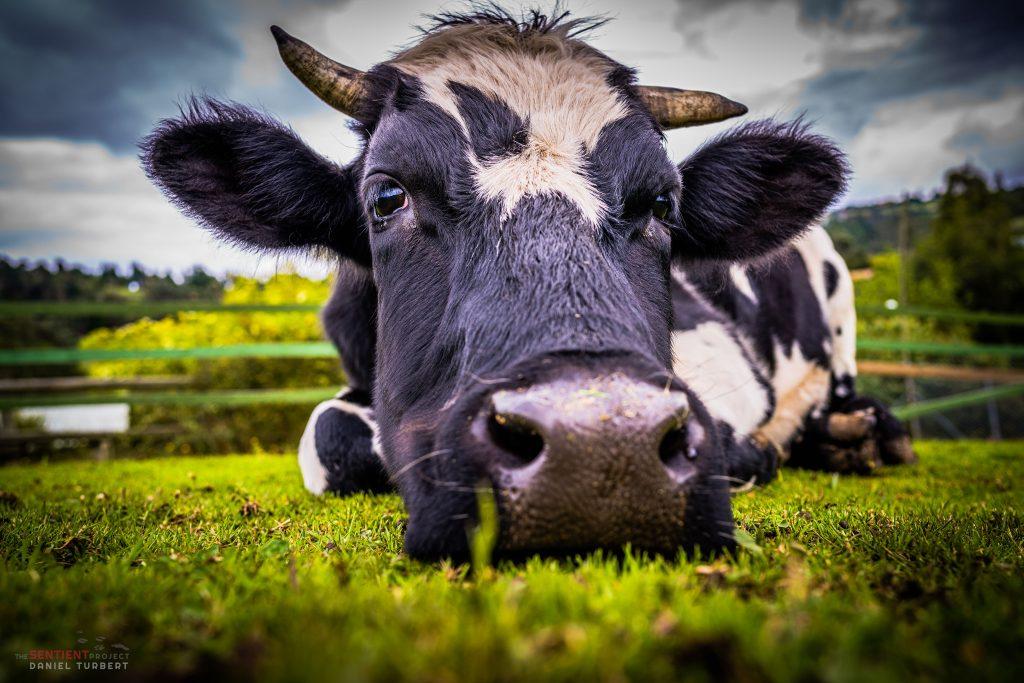Farm animals are kept in dirty and cramped cages in factory farms all over the world, where their physical activity is limited and they are force-fed calorie-dense feed. When animals like cows and chickens are no longer useful for their milk and eggs, they’re shipped off to a slaughterhouse where they are butchered for their meat.
Farm animals are animals too and they deserve to live lives of dignity. Not to mention, many farm animals are also very smart. Did you know that pigs are smarter than any domestic animal? They know when they are about to be killed, and the fear they experience is very real.
So, if we care about our companion animals, we should also care about farm animals and advocate for their health and well-being just as much.
What is a farmed animal sanctuary?
Did you know that the natural life expectancy for a cow is 20 years?
Despite this, most dairy cows live an average life of only 5.5 years and beef cattle never makes it beyond year two before slaughter. The same goes for factory farm-raised chickens and pigs.
Even for the very few days those animals get to experience life on this earth, those farm animals in factory farms will rarely receive the chance to experience any kind of freedom.
Farm animal sanctuaries provide a safe haven for these animals who have been exploited and victimised. Free from the fear of slaughter, rescued farm animals are free to roam about the sanctuary in peace. If you have ever had the opportunity to rub the belly of a pig or run your fingers through the soft tuft of a cow’s big head, you know that donating or volunteering for sanctuaries devoted to animal protection is a must for animal lovers.
What is a rescue farm?
A rescue farm is where farm animals rescued from exploitation are brought to be cared for and protected for the rest of their lives. It aims to give farm animals the freedom and dignity that they deserve. Also, it does not buy, trade, or breed animal residents, neither does it use them for animal testing. Additionally, no products from animals, such as wool, milk, or eggs, are commodified.
Zoos allow unescorted public access to their facility. However, the ogling and noise can stress out the animals. A legitimate animal sanctuary avoids putting the animals they care for in an unduly stressful situation. That’s why most sanctuaries do not allow public viewing of animals.
Some do allow limited and supervised public interactions with mild-tempered and willing residents. If you really want to care for these animals and make a deeper connection with them, the best way to do this is to volunteer at your choice of animal sanctuary.
What do animal sanctuaries do?
Animal sanctuaries rescue and care for animals who have been the victim of inhumane treatment of their previous owners. One of their primary goals is to reduce the suffering of animals by changing the way humans think of and treat animals, especially farm animals. They also place animals with compatible companions of the same species to help develop their natural social abilities to form packs and herds, as well as build relationships.
Animal sanctuaries seek to care for the animals until their natural death. However, there are also some who offer rehoming services. At animal sanctuaries, animals can be housed either permanently or temporarily until a good home is found for them.
Are sanctuaries good for animals?
Imagine being raised in captivity or suddenly getting plucked out of your home and put in a cage. It’s not a nice thought, right? Well, it’s an even worse experience, but animals in zoos and factory farms have to endure such a life.
In a sanctuary, they are cared for and given the respect and love they need in order to recover from the negative effects of abuse they have endured from their previous situations.
How does an animal sanctuary help protect animals?
Animal sanctuaries provide new homes for abandoned animals, as well as those rescued from dangerous situations. They help protect animals from abuse and illegal activities.
In an animal sanctuary, the residents come first. The sanctuary and the caregivers act on behalf of the animals. Both human and non-human residents are given equal importance.
Why do we need animal sanctuaries?
Animals living in captivity and used for illegal activities only have animal rights activists on their side. When they do finally get their freedom, where do they go? They have lived most (if not all) of their lives in captivity, so they don’t have any home to return to. This is where animal sanctuaries come in. They provide a new home for these poor helpless animals so that they can live the rest of their lives with happiness, pride, and dignity—three things they have never experienced before.
Can you visit our animal sanctuary?
While many animal sanctuaries do not allow visitors, at Juliana’s Animal Sanctuary, we give visitors and volunteers a chance to interact with our animal residents.
Our volunteer program allows you to interact with the animals. However, do take note that as a volunteer, you are expected to do your share of the workload. That means waking up early in the morning to empty the kitty litter trays, clean the pathways, feed the animals, fix the fence, play with the dogs, brush the animals, and many more. While that may sound a lot of work, interacting with the animals is a lot of fun.
Our rooms may not be a 5-star hotel suite, but they are clean and comfortable. We also have a fully-equipped kitchen that is open for both volunteers and guests to use.
We are also open for day tours. You may join our tours on March 18, April 15, and May 13 at 1 PM to 2 PM.
What animals do we have in our sanctuary?
At Juliana’s Animal Sanctuary, we currently have 130 animals of different species—from cows, pigs, dogs, and cats, to horses and rabbits. As you can see, we do not discriminate between species. If an animal needs our help, we will give it to them with all our hearts.
Some of our most popular animals are:
- Baby Perla the Pig
- Balko the German Shepherd
- Poldark the Pig
- Mr Chong the Rabbit
- Zeus the Cat
How can you help our animal sanctuary?
With our animal resident population continuously growing, we need all the help we can get. Volunteers are more than welcome to help us with the daily duties of maintaining our farm.
If you can’t be here personally, there are also remote volunteer opportunities where you can send help from the comfort of your own home. A donation of as little as $1 every day goes a long way. It helps support and cover the maintenance expenses of our farm. You can also sponsor an animal, do fundraising, or help us create nice videos. Whatever help you can give—big or small—we will be forever grateful for.


